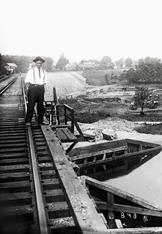“O, what a place for a lake!” Those were Andrew Carnegie’s words, according to contemporary reports, when he saw Princeton’s Millstone River Valley. That phrase also is the title of an exhibition marking the centennial of Lake Carnegie that opens Sunday, April 9, in Firestone Library’s Milberg Gallery.
Carnegie funded the work that created the lake in 1906 at the south end of Princeton’s campus. The construction of a dam in Kingston at the confluence of the Millstone River and Stony Brook flooded the swamps around the Washington Road bridge. Today the lake, which measures three and a half miles long and 800 feet across at its widest point, serves as the home for Princeton’s crew program and as a recreational venue for local residents.
The story of how the lake came about is one of serendipity, according to University Archivist Dan Linke, who curated the exhibition of some 60 photographs and other materials from Mudd Manuscript Library.
Howard Russell Butler, a member of Princeton’s class of 1876, had established himself as a painter and was asked to do a portrait of Carnegie. While the Scottish-American steel magnate was sitting for Butler in 1902, Carnegie discussed the lochs he had built in Scotland. Butler, who had participated in varsity crew at Princeton, mentioned a scheme he and his teammates had hatched to build a lake at Princeton. During Butler’s time, the team rowed on the narrow Delaware and Raritan Canal, where it competed for space with commercial boats traveling between New York and Philadelphia.
“Although Woodrow Wilson had made a low-key solicitation to Carnegie to help fund academic innovations at Princeton, it was Butler’s mention of the desired lake that fired Carnegie’s imagination,” writes Linke in the supporting material for the exhibition.
Carnegie asked Butler to investigate the feasibility and costs. After consulting with a New York engineering firm, Butler reported to Carnegie that a lake could be constructed for $118,000 (about $2.5 million in today’s dollars). “It was one of the great underestimations in Princeton’s history,” Linke writes. “The final cost would be about $450,000 (about $9.5 million today).”
Carnegie traveled to campus to view the site, and also wrote to retired U.S. President and Princeton resident Grover Cleveland to discuss the matter. He then authorized Butler to set the project in motion. In 1903, a group of Princeton alumni began buying the farmland that occupied much of the projected lake’s basin, which they in turn sold to Carnegie.
“Their discreet work allowed Carnegie to amass the acreage without raising the suspicion (or prices!) of local residents,” Linke writes. “By 1905, the necessary land was secured, and crews set to work felling trees, pulling and burning stumps, moving earth, and constructing bridges and the dam.”
The lake’s official opening took place on Dec. 5, 1906. Carnegie traveled to Princeton on a special train car and joined an academic procession into Alexander Hall. “The assembled students, having been given the day off from classes to attend the ceremony, warmly greeted him,” Linke writes. “Wilson graciously thanked him, and then Carnegie delivered remarks praising Princeton’s Scotch heritage and its contributions to the nation.”
Carnegie returned to Princeton the next spring for the lake’s first regatta — but did not give another gift to the University. When Wilson approached him about a second donation, Carnegie is reported to have said, “I have already given you a lake,” and Wilson is reported to have replied, “We needed bread and you gave us cake.”
The lake, however, did more than provide an excellent place for rowing and a scenic setting. The parcels purchased adjacent to the lake added hundreds of acres to the University’s land holdings.
In subsequent years, work continued on Lake Carnegie. The shallowness of the lake led to silting and subsequent flooding, and the University dredged the lake three times in its first 65 years: in 1927, in the late 1930s and in 1971. The last excavation gave the lake a uniform depth of 9 feet at a distance of 35 feet from the shoreline.
The “O, What a Place for a Lake!” exhibition will open with a special lecture on April 9 and run through Sept. 24. Milberg Gallery hours are 9 a.m. to 5 p.m. Monday through Friday; 9 a.m. to 8 p.m. Wednesday (except for August and the first two Wednesdays in September, when the hours are 9 a.m. to 5 p.m.); and noon to 5 p.m. Saturday and Sunday.







